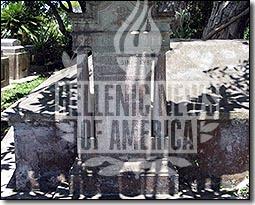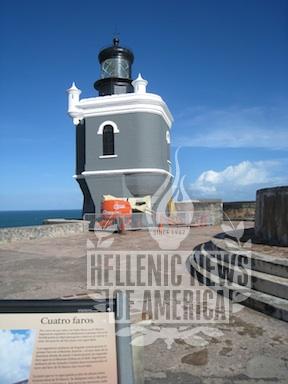
American tourists to the Caribbean are amazed by the Greek influence. A subjugated people, without a country, the Greek culture made its mark in the new world. Greek mariners, with Hispanic names navigated the waters. But, the Greek language also made its mark on the Caribbean.
“The word faros in Spanish comes from the Greek language,” said the park ranger at the Castillo San Felipe del Morro (El Morro) in Puerto Rico. “It means light house. What did the Greeks not invent? The first lighthouse was the Colossus of Rhodes, one of the seven marvels of the ancient world, before the famed lighthouse of Alexandria, Egypt.” This revelation was part of a free tour of El Morro, the 16th century citadel, conducted in San Juan, Puerto Rico. Every Saturday and Sunday afternoons, a free trip of the lighthouse is offered in El Morro Castle to the public.
El Moro was built on the northwestern point of San Juan, Puerto Rico, in honor of king Philip II of Spain in 1539. The lighthouse was built on top of the Castillo in 1843. In 1908, the U.S. military replaced it with the current lighthouse. The original lighthouse was destroyed by US warship fire during the 1898 bombardment of the city. In 1983, El Moro was declared a World Heritage site. El Morro was a Spanish defensive military fortification that protected Puerto Rico, “the Key to the Antilles”.
The Paleologos family of Byzantium left its imprint in Barbados. According to the Cemetery and Memorial Parks website of Barbados, “One intriguing feature of the St John’s Parish Church Cemetery is probably found outside in the graveyard where the tomb of Ferdinando Paleologus (son of Theodore) rests. Paleologus was a descendent of the brother of the great Emperor Constantine XI, the last of the Byzantine Imperial family from the 1400’s that produced the last Christian emperors of Greece. He fled to Barbados after the 1645 Battle of Naseby in England….. He was a church warden of St. John’s Parish having lived there for 20 years where he owned a 197-acre plantation. He managed it from 1649 to 1670 and later died there in 1678.When Paleologus died, he was naturally buried in the St John’s Parish Church, since he had been a prominent person in that community. He left behind a legacy of mystery which until 1844 was buried at St John’s. It was said that he was buried ‘backways’. The rumors persisted until nearly 200 years later in 1844 when a curious church official ordered the vault opened.”

“Paleologus lead coffin was found to have been in a different position to all the others. As the lid was opened, his skeleton was found lodged in quicklime. He had been buried according to Greek Orthodox traditions, which amongst other things, demanded that the dead person’s head should point to the west and their feet to the east. The dignified memorial, wrought in Portland stone portrays a Greek temple with Doric columns surrounding the cross of Constantine carved in the center. The following inscription may still be read:
Here lyeth ye body of
Ferdinando Paleologus
Descended from ye imperial lyne
Of ye last Christian
Emperors of Greece
Churchwarden of this Parish
1655-1656
Vestryman, Twentye years
Died Oct. 3 1678
Ferdinando Paleologus
Descended from ye imperial lyne
Of ye last Christian
Emperors of Greece
Churchwarden of this Parish
1655-1656
Vestryman, Twentye years
Died Oct. 3 1678
The estate of Ferdinando still survives today (2005) as a working farm now called the “Ashford Plantation”. Inevitably becoming a tourist attraction, since in the 1980s, when the Ashford Bird Park and animal sanctuary were opened there.” Greek language and culture is a treasure belonging to the international community.

Δεν υπάρχουν σχόλια:
Δημοσίευση σχολίου